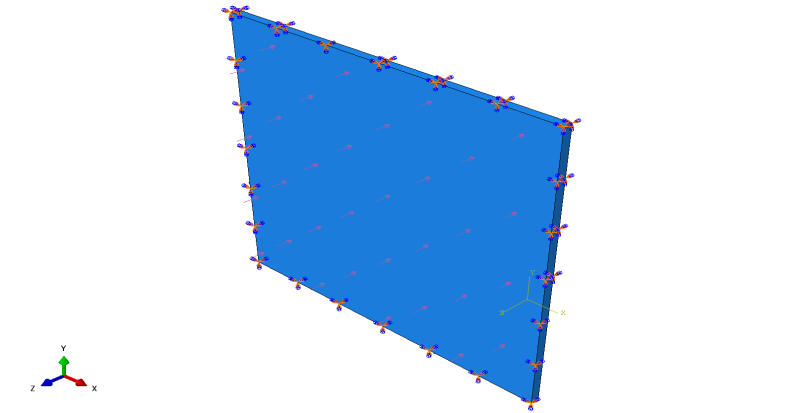kangdongyu
Civil/Environmental
Hello,
I made a 3D concrete slab(Solid-Extrusion) and I did not apply gravity load. I calculated dead load and service load together and applied the total load on the slab as uniform pressure. In addition, I did not use 'Reduced integration'.
To check the model I used closed form formula with table for non-cracked sections from Bares,1971. (w = k(a^4*q/E*h^3))
Here is information for my concrete slab
Span length along x-x direction = 8 m
Span length along y-y direction = 8 m
Slab thickness = 0.203 m
Total load = 7900 Pa
k = 0.0143 from table [Bares, 1971]
Deflection from the formula is 0.001871
Deflection from the Abaqus is 0.001986
Those values are close so I tried to change my slab thickness
When changed thickness is 1.575 m
Deflection from the formula is 4.0e-6
Deflection from the Abaqus is 6.49e-6
When changed thickness is 0.1 m
Deflection from the formula is 0.01505
Deflection from the Abaqus is 0.01984
BC = rigid supports and rotationally fixed (In abaqus, I set surrounding surfaces up as fixed supports.)
As you can see there is very big difference when the thickness is large.
Link
If you look at page 25 of the link, the table shows deflections from different methods.
When concrete slab thickness is small, values from closed form and FEM-No allowance for cracking are quite similar.
However, when I increase the slab thickness then values difference is really big.
Therefore, I would like to know why there is big difference when I have big slab thickness.
I will very appreciate your help!
Thank you!

I made a 3D concrete slab(Solid-Extrusion) and I did not apply gravity load. I calculated dead load and service load together and applied the total load on the slab as uniform pressure. In addition, I did not use 'Reduced integration'.
To check the model I used closed form formula with table for non-cracked sections from Bares,1971. (w = k(a^4*q/E*h^3))
Here is information for my concrete slab
Span length along x-x direction = 8 m
Span length along y-y direction = 8 m
Slab thickness = 0.203 m
Total load = 7900 Pa
k = 0.0143 from table [Bares, 1971]
Deflection from the formula is 0.001871
Deflection from the Abaqus is 0.001986
Those values are close so I tried to change my slab thickness
When changed thickness is 1.575 m
Deflection from the formula is 4.0e-6
Deflection from the Abaqus is 6.49e-6
When changed thickness is 0.1 m
Deflection from the formula is 0.01505
Deflection from the Abaqus is 0.01984
BC = rigid supports and rotationally fixed (In abaqus, I set surrounding surfaces up as fixed supports.)
As you can see there is very big difference when the thickness is large.
Link
If you look at page 25 of the link, the table shows deflections from different methods.
When concrete slab thickness is small, values from closed form and FEM-No allowance for cracking are quite similar.
However, when I increase the slab thickness then values difference is really big.
Therefore, I would like to know why there is big difference when I have big slab thickness.
I will very appreciate your help!
Thank you!

